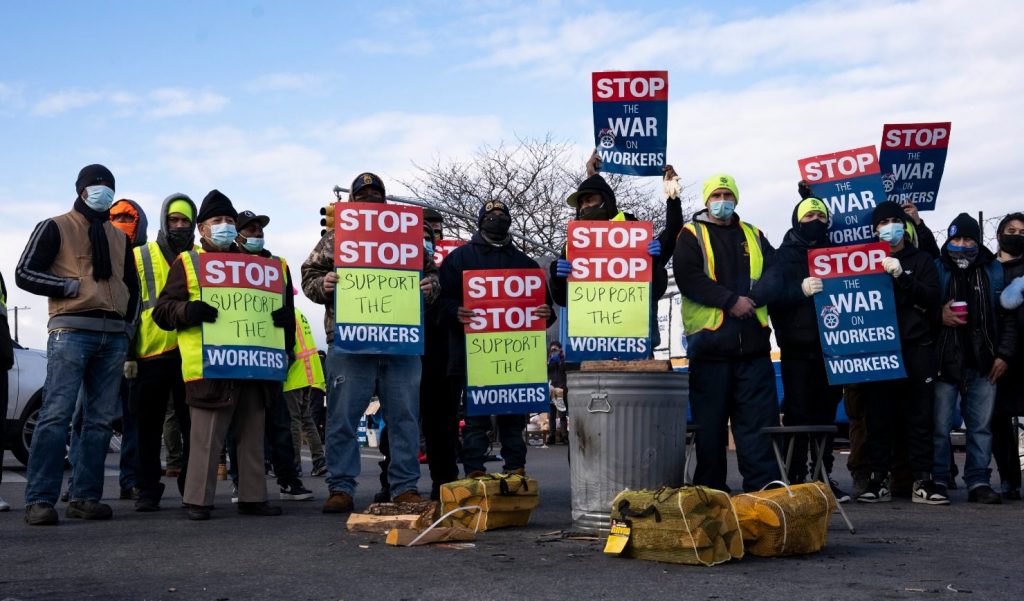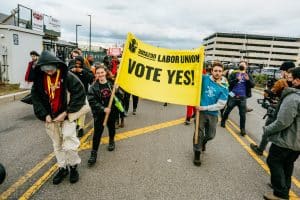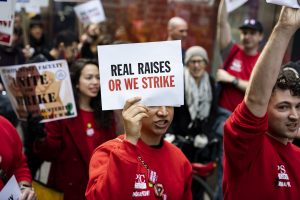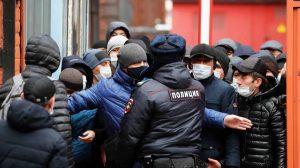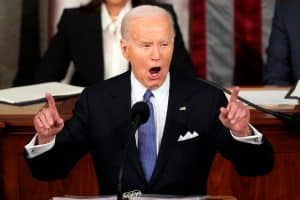Last week, 1,400 workers at Hunts Point Produce Market in the Bronx went on strike. The wholesale market is the largest in the United States and one of the largest in the world, supplying food to over 22 million people. The market is also responsible for feeding over 60 percent of people living in the NYC region. After contract negotiations fell apart on Saturday, June 16, workers organized with Teamsters Local 202 went on strike to press for a $1 raise for each year of the contract. Workers at the market previously earned between $18 to $21 per hour, with many working overtime in order to make ends meet. The bosses — owners of multiple small and large distribution companies — refused these terms, offering a paltry 32 cents instead, and told the workers that they should be “thankful to have a job” through the pandemic. Yet, as we saw through the pandemic and even now, these are the workers who kept the system running while the bosses fled to their Long Island mansions. The strike forced the bosses back to the bargaining table on Thursday night, where they reached a tentative agreement with the union leadership. On Saturday, the rank-and-file members voted overwhelmingly in support of the contract and went back to work on Sunday.
You Might Be Interested in: How Do You Like These Apples? 1,400 Hunts Point Workers Are on Strike
Left Voice comrades spent a great deal of our week with the workers, listening to their stories and their anger. But strikes are also schools of war, teaching us important lessons and preparing us for our next battles against the bosses and the state. Here are some of the main lessons to take away from the strike.
One: Workers Are Essential; Bosses Are not
The strike showed, above all, the strength of the strategic position of the working class within capitalism. The workers at Hunts Point are responsible for receiving, stocking, handling, and distributing produce all over the United States. They are the ones responsible for keeping our grocery stores stocked. Worker after worker told us how their bosses hadn’t stepped foot into the market since the start of the pandemic, fleeing the city to escape the virus, while the workers at Hunts Point continued to come in every day. They are some of the very essential workers that kept the system running through the pandemic. But they aren’t the only ones — workers everywhere, in the service industry, food distribution, healthcare, education, logistics, etc. are the ones who quite literally run the world.
With last week’s strike, workers at Hunts Point Market leveraged their strategic position, where they have the most firepower, and fought together to force the bosses back to the bargaining table. Each day they were on strike, they not only risked millions of dollars worth of produce spoiling on the warehouse floors, but also threatened food distribution across the eastern United States. When we speak of the strategic position of the working class, it isn’t an abstraction. Workers are the ones who not only produce everything that is essential for sustenance, but also everything of value to capitalism. In The Communist Manifesto, Marx says, “the bourgeoisie therefore produces, above all, are its own grave-diggers” — and we see it to be true. To fight against the bosses for better conditions, but also against the state that continues to attack them, it is essential that workers, organized as a class, use their strategic position within capitalist production to flex their muscles and win.
But workers can also go further. They are the thousands who run the market, stocking it with produce and running the logistics for distribution to markets and stores across New York City, and they have done so for decades. They have shown time and again, and especially through the pandemic, that they don’t need bosses. Such a market can and should fight to be nationalized under workers’ control, their hours divided without reduction in wages among the unemployed so they don’t have to do back-breaking ten-hour shifts and have the opportunity for rest and leisure. Whether in the midst of the pandemic or without one, our lives are always worth more than their profits.
Two: The Working Class is Multiracial
For decades, bourgeois propaganda has propagated blatant lies about our class. First, they declared that the working class is dead and they no longer were a vehicle for social change. Now, they define the working class narrowly as “those without a college degree,” and continue to paint the working class as uneducated, reactionary, Trump-supporting white men in the Midwest. But the working class is far more than that. Making up the majority of the population in the United States and across the world, the working class is multiracial — we also are Black, Brown, queer, women, and immigrant.
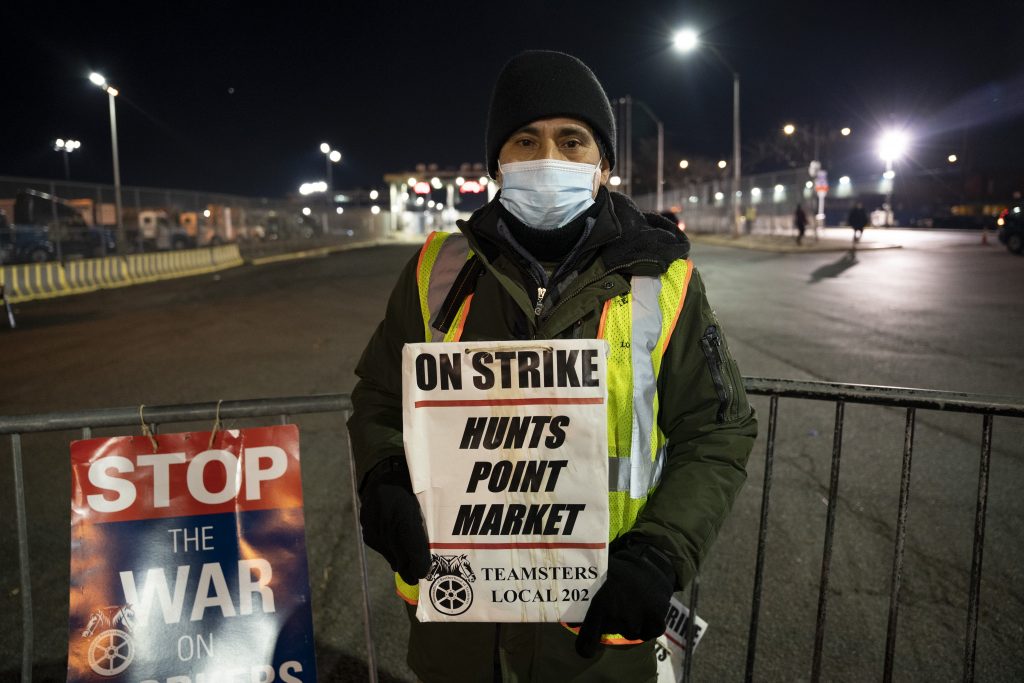
The Hunts Point strike was a display of our class in all its stripes. Challenging the binary idea of the “working class” put forth by bourgeois media, the Hunts Point strike showed us workers, who were Black, Brown, and immigrant, doing essential work in New York City. In the United States, which was founded on racial oppression of Black people, Black and Brown workers continue to face the worst assaults of racism. In an echo of this past summer’s Black Lives Matter movement, Black and Brown workers chanted “hands up, don’t shoot” as police in riot gear charged at them last week for blocking the highway. The police, who are descendants of strike breakers and slave patrols, continue to act as the armed wing of a capitalist state that weaponizes racism to attack and exploit sectors of the working class.
Workers at Hunts Point, furthermore, were also immigrants, many having emigrated to the imperialist superpower that is the United States for better opportunities. Many workers shared stories of how younger, immigrant workers continued working through the strike out of fear of losing their jobs. Workers also, with the union’s assistance, often help others with their visas, papers, and IDs. While the bosses use race and immigration statuses to divide them, the workers actively fight against these forces, working together to strengthen their ranks for they understand that they are only stronger when they fight together.
Against the police, against ICE, and against the racist, capitalist state, the fight against racism and all forms of oppression is and has to be an essential part of our struggles as a class.
Three: Solidarity is Essential
As news of the Hunts Point strike spread, hundreds flocked to the market to show their support for the strike. From organizing ride shares to helping provide food and supplies to striking workers, left organizations across the tri-state area organized efforts to have people show up in solidarity. We, at Left Voice, had members visit the picket every day, talking with workers, listening to and sharing their stories with articles and videos in support of their strike.

Through the week, New York state and city council members, including Congresswoman Alexandria Ocasio-Cortez, also showed up to show their support.
While workers were the one who fought and won concessions from the bosses, the outpouring show of solidarity played an essential part in boosting their morale, reaffirming their decision to take on this fight. Speaking to workers through the week, they reiterated their gratefulness of the community’s support and the effect it had on their morale and resilience to keep fighting. For many, this experience also made them want to fight for other workers, when they take on those fights in their communities and workplaces.
The solidarity shown by the community not only helped swell the ranks of striking workers and boost their morale, but it also helped spread the word. With the news of the strike and the support it received becoming national news, it acted as a pressure on the bosses to reach a resolution soon to avoid further embarrassment.
Four: We Need to Fight for Workers’ Democracy
Although workers were fighting for a $1 raise for every year of their contract period, they eventually won a $1.85 raise over a 3 year period — 70 cents the first year, 50 cents the second, and 65 cents the third, along with two extra personal days and one extra sick day. Rank-and-file workers we spoke with after the contract was ratified spoke of how it was a partial victory for them. The contract wasn’t everything that they were fighting for, but it was “good enough.” So, how did workers end up with this contract, and what could they have done differently?
Throughout the week, the union leadership ran a tight ship over the proceedings. After workers took over the avenue leading to the entrance and were beaten back by the police, the union leadership instructed workers to stay within the barricades by the side of the entrance and not obstruct it. Throughout the week, both other unionized workers and hired scabs could freely enter the market to work, as could other freight trucks, weakening the effectiveness of the strike.
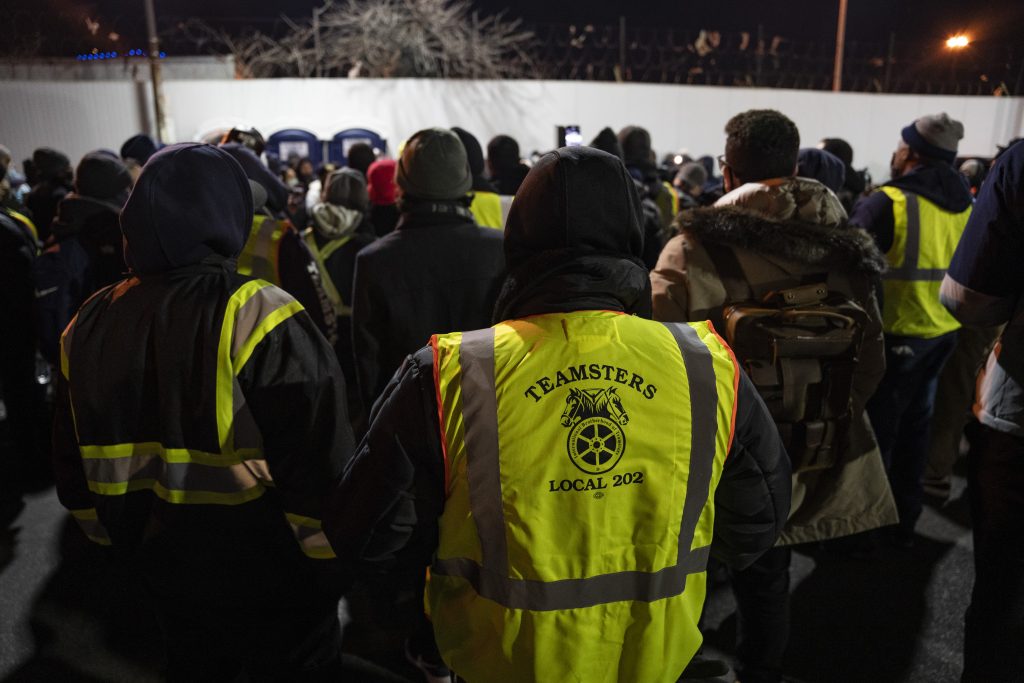
The national leadership also made no efforts to mobilize the rest of the union to exert pressure on the bosses. Today, Teamsters are organized in strategic sectors across the nation. Together, they have the power to shut down key sectors of the economy, a power that was completely squandered by the union bureaucracy.
Furthermore, although the union leadership went to the bargaining table on Thursday night, it wouldn’t be until Saturday morning that workers found out what was in the contract. On Friday evening, before the contract was announced, the president of the local, Danny Kane, announced that the workers had won even before they went inside for contract negotiations. This was a claim he repeated the next morning, in front of workers, along with telling them to ratify the contract before they even had a chance to learn the details. Workers went into the market to vote and were out in about an hour, with the contract ratified. It is unlikely that any of the workers had a chance to read the pages in the contract stipulating these new agreements prior to ratification, let alone debate and discuss before the vote. For the union bureaucracy, the strike is a pressure tactic that allows them to establish and maintain their positions of leadership among the workers — positions with which they enrich themselves — as opposed to an experience in self-organization of the working class. Workers enter these strikes with their hands tied behind their backs.
To fight against these bureaucratic maneuverings, we have to fight for workers’ democracy. In assemblies, workers should have the chance to debate, discuss, and vote on everything they are doing, from how they organize the strike to the details of the contract. Instead of being pulled back by their leaders, workers should have an opportunity to discuss whether they want to take over the highway or the market entrance. Workers should also have access to contract details and enough time to read, understand, and discuss it, instead of artificially declaring a victory. Unlike what Danny Kane believes, the fight isn’t won simply by having decided to fight — it is won in full when the demands are won. The ability of workers to organize and democratically decide among themselves on every aspect of the fight further strengthens them for future fights to come. As Lenin wrote in 1906, “The strength of the working class lies in organization. Unless the masses are organized, the proletariat is nothing. Organized—it is everything.”
Five: We Need to Fight for Class Independence
Although many Democratic party politicians stopped by the picket line at Hunts Point over the week, boosting the morale of the workers and useful in gaining visibility, we have to be clear that they still, above all, are representatives of one of the two biggest capitalist parties in the world.
Whether as the champions of globalization or the party that bailed out Wall Street at the expense of working people after the 2008 crisis, Democrats have always used their place in office to attack workers. As one of the architects of the neoliberal order that has attacked the rights and dignity of workers in the United States and across the world, the Democratic party is no friend of the working class. For workers, therefore, fighting against the Democratic party is as essential as fighting against the bosses. This is especially true as Joe Biden begins his presidential term, with a cabinet full of representatives of the capitalist class.
At Hunts Point, furthermore, aligned with the union bosses, Democratic Party politicians (like sectors of the left) played a conservative pressure on the picket line, declaring a premature victory on Friday evening before workers had a chance to learn of the details of the new contract. AOC, leading the charge, congratulated workers on their “win” before workers even knew the contents of the contract.
The union leadership led by Danny Kane, on their part, while congratulating workers for fighting, put their victory at the feet of Andrew Cuomo, declaring that it was his call to the bosses and the support of Democratic party politicians that led to their victory. But Democratic party leaders like Cuomo weren’t moved by benevolence. The workers at Hunts Point won because their actions threatened to create a crisis in the food supply chain in the eastern belt, forcing politicians in power to pressure the bosses.
The alliance between union bosses and the Democratic party is a long one. In 2020 alone, the International Brotherhood of Teamsters donated $1.7 million to Democrats and Democratic party-aligned groups — money obtained from members dues that could otherwise go to strike funds and help striking workers. Instead, the union bureaucracy continues to conspire with the very representatives of the bosses.
There can never be any alliance with our oppressors. To strengthen our ranks and our fight against the bosses and against capitalism, workers need to fight for class independence and for an independent socialist perspective. Here in the United States, this especially means breaking all ties with the Democratic Party.
Six: We Can Win
Although the workers didn’t win the full dollar they were fighting for, this partial victory is an important one. The workers at Hunts Point Market showed us the strength of the strike as a weapon in their hands. It showed that when workers stand together and fight together as a class, from their place of strength and withholding their labor, they can strike at the very heart of the capitalist machine, and they can win.
You Might Be Interested in: Hunts Point Market Workers Win Wage Increase After Strike
In this struggle, the workers at Hunts Point showed a high level of class consciousness. Many expressed their anger at their bosses clearly, at how the bosses made millions off of their labor. They were the ones who made the bosses rich. By standing at the picket together, they could also halt those very millions from flowing into their pockets.
In the face of rotting produce on warehouse floors and empty shelves in grocery stores across New York City, under the pressure of elected officials, the bosses were forced to return to the bargaining table and offer far more concessions than they were willing to. But let’s be clear — they were forced back because of the indispensable role the striking workers played in their business and in the economy. These struggles can inspire millions of workers not only in the Hunts Point and New York City region, but across the country.
To win not only economic demands, but also social, economic and political power as a class, it is essential for us, as workers organized in our workplaces, to fight with our methods of strikes and pickets. In our struggle against capitalist oppression and for socialism, the strike is a powerful tool.


